Beowulf
Created by: Santiago García and David Rubín
Published by: PUBLISHER
ISBN: 1534301208 Amazon
Pages: 200



Every society, every culture, every niche of the human experiment has its monsters. You just have to know where to look. Whether the Jewish Lilith, broxa, or Rahab. Whether the Greek cyclops, Minotaur, or Gorgon. Whether the sailors' Kraken, the mermaid, or sirens. Whether the Japanese yokai, Chinese qilin, Australian bunyip, or Islam's Dead Sea apes. Monsters abound, each fulfilling their own role in the structure of the societies they haunt.
The Christian mythos, long dominant in the West, has its fill as well—many proliferating in the medieval era. Dragons are tied to the Serpent that tempted humanity in the Earthly Paradise, and were often only defeated by those in tune with the sacred call of the Divine (e.g. St George). Ghosts linger as remnant scatterments of the damned, exacting often arbitrary retributions as mindless graspings for revenge. Demons make their homes in the hearts of men, women, and children, causing mayhem and disaster, and are former angels, twisted from their original state of noble beauty for (or from) their violent rebellion against God. Even vampires, whose Western tradition arrived rather late, are in the West intimately tied the trappings of Christian faith, being subject to Holy Water, holy ground, crosses, sunlight, and faith. But among the more well-renowned monsters of the Christian folklore is Grendel (even more so than his mother, who is really only known as "Grendel's Mother").
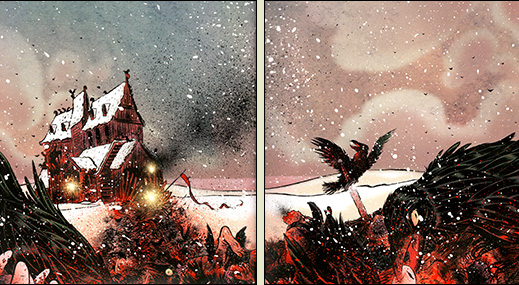
Whether "God-cursed Grendel came greedily loping" (Heaney, 711) or "Grendel gliding, God's wrath on him" (Rebsmen, 711), reference to the Christian foundation to the myth is essential in understanding the role of the creature. Beowulf, though obviously apocryphal to the religion (it's unlikely that you'll ever wander into a church preaching through the saga), is founded in Christianity and traffics deeply in the the religion's vernacular as coin of its realm. Grendel and his kind are the offspring of the first murderer, Cain the killer of his kin-blood who, being ever cursed by the Shaper and Measurer of our world, sired evil and cunning man-killers, banished from heartlove and born in hatred (Rebsamen, 106–112).
From Cain came ogres and trolls and elves, but more—from Cain came Grendel. Monster of monsters. Beowulf begins with a hearty description of the Spear-Danes, whose heroic campaigns raised from a wasteland walls of glory. And yet these mighty men fall fully under the power of Grendel, a creature none can thwart. Has God's light left his people (for yes, Christianity had infiltrated Northern Europe by this time and the great Danish Christian viking king Canute began his reign in AD 1017)? Beowulf's temporary answer at least is Of course not because, "Oh hey look who it is: Beowulf!" And indeed, reference to Almighty God and his graciouness pepper the narrative so that we remember that there by the grace of God goes our hero.
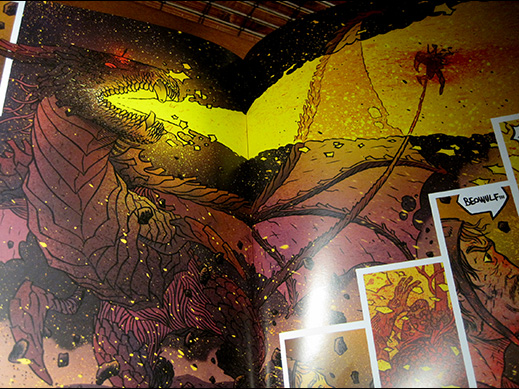
So yes, the Christian foundation to the story is entirely essential. Although, maybe not, since García and Rubín sever any reference to the mythos in their vibrant retelling of the fable.
Now let's interject here with a short discussion of comparison of interpretations. Because there's nothing so interesting as comparison. Beowulf, depending on whom you ask, opens as such:
In Hall:
"Lo! the Spear-Danes' glory through splendid achievements. The folk-kings' former fame we have heard of, how princes displayed then their prowess-in-battle."
In Heaney:
"So. The Spear-Danes in days gone by and the kings who ruled them had courage and greatness. We have heard of these princes' heroic campaigns."
In Rebsamen:
"Yes! We have heard of years long vanished, how Spear-danes struck, sang victory songs, raised from a wasteland walls of glory!"
In Gummere:
"Lo, praise of the prowess of people-kings, of spear-armed Danes, in days long sped, we have heard, and what honor the athelings won!"
In Raffel:
"Hear me! We've heard of Danish heroes, Ancient kings and the glory they cut for themselves, swinging mighty swords!"
In Liuzza:
"Listen! We have heard of the glory in bygone days of the folk-kings of the spear-Danes, how those noble lords did lofty deeds."
In Alexander:
"Attend! We have heard of the thriving of the throne of Denmark, how the folk-kings flourished in former days, how those royal athelings earned that glory."
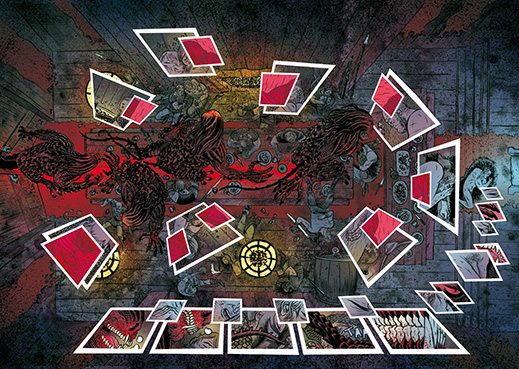
Translation, the adaptation of a text for an audience for whom that text was not originally intended, is a tricky business. There's never really going to be a right answer. Plenty of wrong answers, but no right answers.
The above is a comparison of several translations of the opening to Beowulf. What it shows more than just which authors are more talented is that there are always going to be a variety of ways to approach a text. And they can each be valid. That doesn't stop us from having preferences—it just means that we prefer one vision or way of revealing a text to another.
Like with the above, I definitely prefer Rebsamen. Compare with Heaney here:
"Spear-danes struck, sang victory songs, raised from a wasteland walls of glory!"
vs.
"The Spear-Danes in days gone by had courage and greatness. We have heard of these princes' heroic campaigns."
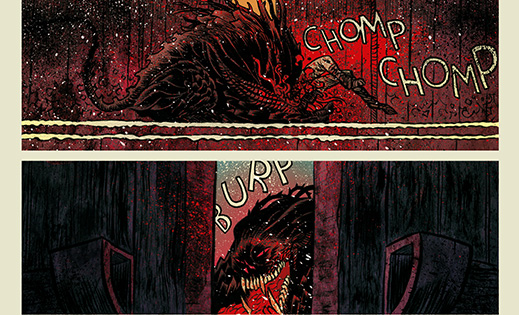
The one is showy, the other is telly. In Rebsamen, the Spear-Danes are doing things; in Heaney, we hear rumour that the Spear-Danes once did things. Are both legitimate adaptations of the original text? Almost certainly. But they underscore, I think rather distinctly, how the purpose revealed in an adaptation is going to depend unavoidably on the goals of the translator.
There are (now) two major comics adaptations of Beowulf11This discounts the more fanciful and less faithful adaptations of the story, like Kid Beowulf, in favour of what we may consider largely "straight" adaptations. In 1999, Gareth Hinds released in three issues an adaptation that makes heavy use of the actual text of Beowulf.22originally using text from Gummere's translation, but switching to Church's for trade paperback collection. Nearly 20 years later, we get a new adaptation—this one from Spain and adapted by Santiago García and David Rubín. And they are substantially different from each other.
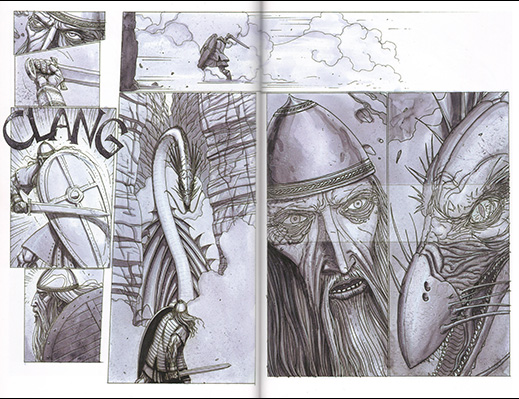 Gareth Hinds does a good job showing Beowulf old and broken at the end of things.
Gareth Hinds does a good job showing Beowulf old and broken at the end of things.
Where Hinds' illustrations are relatively static and artfully posed, Rubín's are wildly dramatic and bursting with life. Hinds feels noble and distant and Rubín feels visceral and present. Hinds' palette is subdued and by the final third nearly entirely desaturated (which does go a long way toward drawing the reader into the stiffness and age-pain in Beowulf's limbs). Rubín's pages burst with colour, especially heavy, groteque reds, emphasizing more trenchantly the violence of the time, of the events. In Hinds, bodies are strewn with thick black splatter connoting the gush of lifesblood; in Rubín, viscera is spilt in vibrant crimson and the organs fly in a tangle of stretching innards that would compare well with Michael Avon Oeming's gratuitously explosive work in Powers.
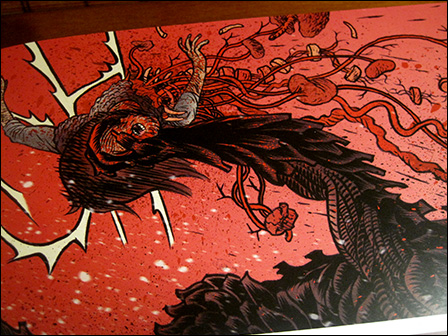 Pray to St Oeming, that your organs might find their way to heaven.
Pray to St Oeming, that your organs might find their way to heaven.
Curiously though, as far as creature-design goes, neither Hinds' nor Runbin's Grendel is much removed from the other. Both are dark, hulking abstractions from the human frame, built of seemingly exposed sinews. Each has their sex emphasized: Rubín's by overtly showing Grendel's penis as he ejaculates onto Beowulf and initiates the fateful battle, and Hinds' by hiding Grendel's member in a mane of snaking thick pubic tendrils. These monsters are each clearly perversions of the masculine male, a twisting corruption of what could have been.
Rubín's Grendel: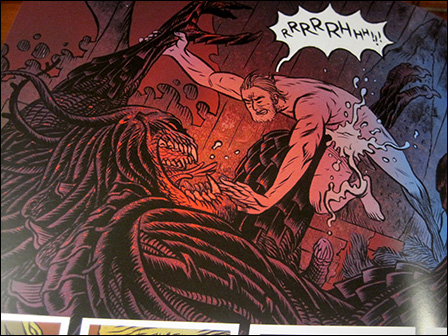 Premature, Grendel. But don't be mad. No shame in it, Buddy.
Premature, Grendel. But don't be mad. No shame in it, Buddy.
vs Hinds' Grendel:
One final note on Rubín's art: it's just fantastic. While thoroughly in the realm of what I've seen from him before in the Aurora West books and the more recent Heracles revamp (The Hero), Rubín's laid out a more grounded (mostly) style than what we saw in The Hero (which is simultaneously more fantastic with its sci-fi/fantasy blend and its more cartoonish vision). Beowulf in his hands is still distant and distinct from realism, but it at least puts us in mind that this story is meant to have happened in our world. The size of these pages is great as well, really giving Rubín's layouts the opportunity to breathe. Even if you don't care for the story of this particular hero and the three monsters (plus Swedes) he faces, Rubín's art may be enough to draw your interest.
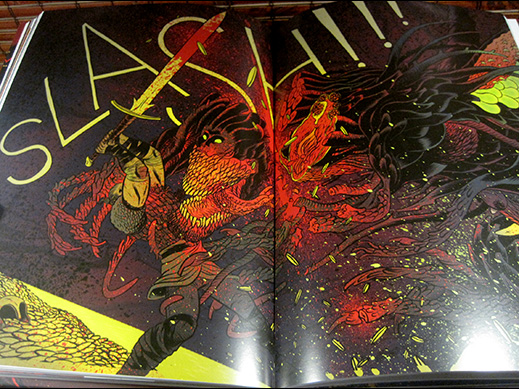
But the differences are more than just in the art. Hinds pulls directly from the text, using only narrative boxes and eschewing dialogue balloons. These text blocks are heavy and depending on what you're reading for may either be a joy or a chore. For me personally, they sit at odds with and distract from the story being told in the art. I felt this in 1999 and I feel it today (usually now when reading Hinds' adaptation, I'll skip entirely reading any of the text and focus wholly on the images—thankfully I'm familiar enough with the Beowulf text that this is plausible for me). For this new work, however, writer Santiago García (whose dream this edition realizes) uses no direct quotation save for in its curious postlogue. Apart from a single "12 years later", I don't believe I remember any other use of narrative balloons. Everything is revealed through direct dialogue. In this sense, Hinds is more similar to the telly Heaney and García to the showy Rebsamen. García's adaptation mirrors Rubín's (they make a good team!) in that both work to promote the action of the story at the expense of (or perhaps to counteract) the distance of one thousand years. In Hinds, the reader feels the ancient quality of the story, that we are privy to something old and foreign. In García and Rubín, there is immediacy. This is no longer something distant nor something foreign.
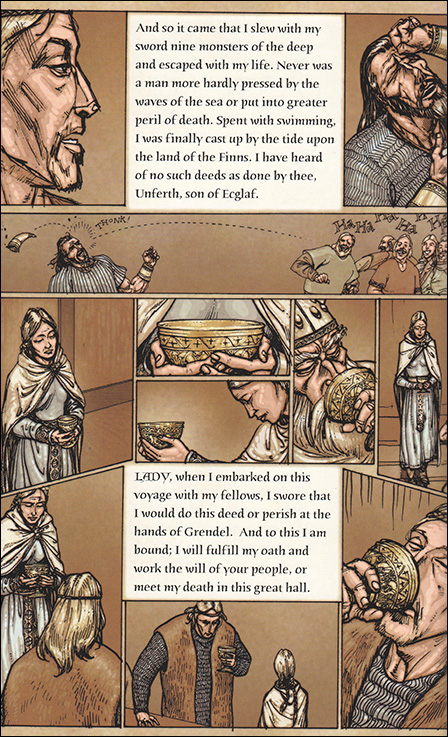 Gareth Hinds and his narrative blocks
Gareth Hinds and his narrative blocks
And then again, the difference is in more than just the art and the writing style. Just as the variety of prose translators choose to emphasize each in their own manner and direction, García and Rubín create a very different kind of Beowulf story by entirely revoking the Christian mythos as the story's foundation. While every prose translation underscores both the hand of God as well as Grendel's biblical origin, and Hinds retains the presence of the Almighty lurking behind the scenes (though only remarking that Grendel derives of a cursed race), García and Rubín have none of it. Their monster is without origin and their story is entirely secularized. It's probably a good question: are monsters better when they merely are or when there is a reason for their existence? Godzilla exists because of the hubris of humanity, but Kong exists simply because he does. Dracula exists because of manifest perversions. Krueger exists because of manifest perversions. Frankenstein's monster exists because of humanity's hubris. The evil dead come to be from humanity's hubris. Jaws exists simply because it does, maybe as an allegorical nudge for humanity to remember their domain and not infringe on the domain of others. Are the monsters that are monsters for a reason better monsters? I don't know, but in this case, I think Grendel is more interesting if he has some tie to the origin of the human species than if he is merely some wandering brute. This is, from my view, the only one of two missteps in this new adaptation. (The other is probably Grendel ejaculating on Beowulf. I still can't decide whether it was spontaneous or if the creature was caught in the midst of masturbating onto the hero. Either way, it probably doesn't matter, but the moment is so strange and unheralded a departure from the source that it sticks out perhaps overmuch as a distraction—in fact, I'm still trying to figure out its purpose and value to the book… maybe it is enough that it simultaneously underscores Grendel as a part of nature while also highlighting how apart he is from civilized interaction.)
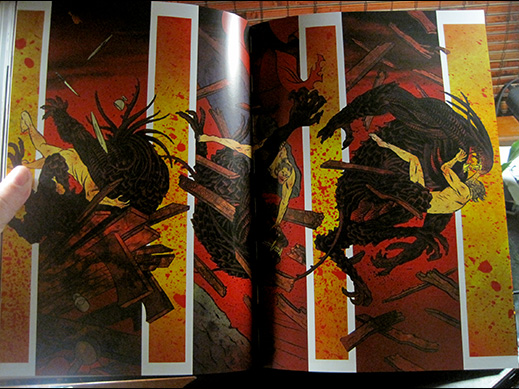
One of the most interesting aspects of García and Rubín's Beowulf is that in its conclusion, the creators transition the reader from myth to fact, from reading the adventure of this monster slayer to being pulled exteriorily into experience a kind of tl;dr rendition of the book's production. We move from seeing that famous Hwæt wê Gâr-dena to a panel of the saga's opening lines (strangely using the Lesslie Hall translation rather than the Heaney one that García references in the aftermatter as the book's source), then to a script description of the eight panels on this book's first page, then to page 1 pencils, then to inks and colours, then to layout of the cover, then to Rubín's email to García that the book is complete, then to it's print and publication and sale and acquirement by a reader and opening by that reader, and then finally, with the book having been opened (within itself!), the book finally ends with FIN. As if Beowulf's life and death, his whole adventure, can only truly conclude with the consumption of his life and death by the reader. Beowulf's goal here is eternal glory and he finally achieves that with each new reader—ironic that in a book that steadfastly elides the hero's religious origins that he must be consumed body and blood by the reader to achieve his final, lasting victory.
Good Ok Bad features reviews of comics, graphic novels, manga, et cetera using a rare and auspicious three-star rating system. Point systems are notoriously fiddly, so here it's been pared down to three simple possibilities:
3 Stars = Good
2 Stars = Ok
1 Star = Bad
I am Seth T. Hahne and these are my reviews.
Browse Reviews By
Other Features
- Best Books of the Year:
- Top 50 of 2024
- Top 50 of 2023
- Top 100 of 2020-22
- Top 75 of 2019
- Top 50 of 2018
- Top 75 of 2017
- Top 75 of 2016
- Top 75 of 2015
- Top 75 of 2014
- Top 35 of 2013
- Top 25 of 2012
- Top 10 of 2011
- Popular Sections:
- All-Time Top 500
- All the Boardgames I've Played
- All the Anime Series I've Seen
- All the Animated Films I've Seen
- Top 75 by Female Creators
- Kids Recommendations
- What I Read: A Reading Log
- Other Features:
- Bookclub Study Guides









